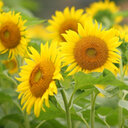Behavior of native species Arrhenatherum elatius (Poaceae) and Sonchus transcaspicus (Asteraceae) exposed to a heavy metal-polluted field: plant metal concentration, phytotoxicity, and detoxification responses.
Ключавыя словы
Рэферат
The application of vegetation cover for the phytomanagement of heavy metal-polluted soils needs prior investigation on the suitability of plant species. In this study, behaviors of Arrhenatherum elatius and Sonchus transcaspicus, two native perennial grasses that currently grow in a mine tailing, were investigated through plant metal concentration, phytotoxicity and their detoxification responses. Both of the species accumulated Ni, Cu, Cd, Co, Mn, Pb, Cr, and Zn in shoots far below criterion concentration as a hyperaccumulators; thus, neither of them were found to be hyperaccumulators. A. elatius accumulated metals in roots and then in shoots, on the contrary, in S. transcaspicus metals were preferentially accumulated in shoots. Plants exposure to such metals resulted in oxidative stress in the considered organs as indicated by the changes in chlorophyll fluorescence, chlorophyll contents, malondialdehyde (MDA) levels and antioxidative enzyme activities. A. elatius seemed to be more affected by metal-induced oxidative stress than S. transcaspicus. Correspondingly, S. transcaspicus showed a greater capacity to adapt to metal-induced oxidative stress, depending on more effective antioxidative defense mechanisms to protect itself from oxidative damage. These findings allowed us to conclude that both of these plant species could be suitable for the phytostabilization of metal-polluted soils.


